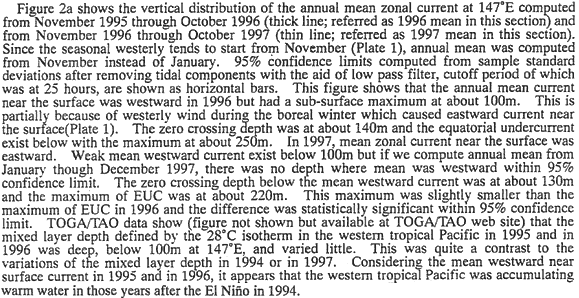Plate 2d shows that a striking deepening of the isotherm occurred during the first NSEC event in December 1996. After this event, isotherms returned rapidly to the depths slightly shallower than the depths before this event at 147°E and to almost the same depths before this event at 156°E. Meridional distribution of temperature across the equator at 156°E observed by TOGA/TAO buoys shows (figure not shown) that the deepening of the isotherm was approximately centered at the equator. These results indicate that the sharp deepening of the isdtherm during this event was mostly due to the equatorial downwelling by the Ekman convergence rather than the mixing. In mid-February, there was an easterly wind event which was stronger at 156°E than at 147°E, and a noticeable shoaling of the isotherm at 156°E and the shoaling of the EUC at 147°E occurred. The deepening of the isotherm at 147°E during the third NSEC in March was much smaller than the one in December 1996. The westerly wind which caused this event started as early as late February at locations near the western boundary. By mid-March, this westerly wind extended from the western boundary to about 175°E. Comparison of Plate 2i with Plate 2h indicates that the scale of this wind event was larger than the one in December 1996. However, Plate 2i also shows that the center of this event was located south of the equator. The low-pass filtered meridional current at 120m at 147°E during this event was northward with a maximum value of 82cm/s (Plate 2e; 17.7cm/s without a filter) while the mean value of low pass filtered meridional current in 1997 at this depth was only 1.6cm/s, and the standard deviation was 17.7cm/s. These data suggest that the forcing due to the westerly wind which was not symmetrical at the equator was less effective in producing equatorial downwelling but did produce more of the cross-equatorial meridional current. It also is expected that non-symmetrical forcing at the equator would excite weaker zonal current at the equator which may explain that the zonal currents during this event were weaker than those during the first NSEC. Plate 2a indicates that significant sea-surface height anomalies occurred only west of 150°E during this period. After the fourth NSEC in April, the 28℃ isotherm started shoaling and reached the upper limit of our observation, 30m, in September.
During the strong NSEC in December 1996, SEC and the upper limit of the EUC were temporarily deepened. After this NSCE, the upper limit of EUC returned to about 130-150m which was not particularly different from the upper limit depth of EUC during boreal winter in other years (Plate 1). The deepening of the upper limit of EUC also occurred at the second, third and fourth NSEC event in January, March and April. These responses of the upper limit of the EUC were synchronous with the deepenings of isotherms, and they were almost simultaneous with the changes of the local wind field, although the amplitudes of their depth variations differed.
3-3 Annual mean zonal current
